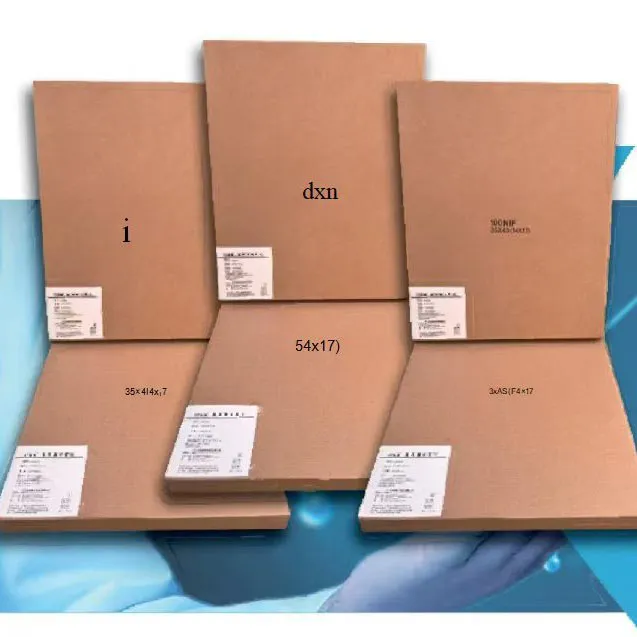


The landscape of medical imaging has undergone a transformative shift with the advent of digital technologies, yet the role of high-quality diagnostic films remains crucial for diverse clinical settings. Among these, dry laser film stands out as a cornerstone technology, offering a robust, environmentally friendly, and efficient alternative to traditional wet-processed films. This innovative film technology simplifies the imaging workflow significantly, eliminating the need for darkrooms, chemicals, and complex processing equipment. Its widespread adoption is driven by the demand for immediate, high-resolution images that are critical for accurate diagnoses and effective patient management. Lucky Medical Dry Laser Film Kx350 exemplifies this advancement, providing superior image quality and operational convenience for medical professionals globally.
This article delves into the intricacies of dry laser film, exploring its underlying technology, manufacturing processes, key technical parameters, and the myriad applications where it excels. We will also examine industry trends, provide a comparative analysis for informed decision-making, and highlight the commitment to quality and support that defines leading manufacturers in this specialized field. Understanding these facets is essential for healthcare providers seeking to optimize their imaging capabilities while adhering to stringent clinical and environmental standards.
Dry laser film, often referred to as dry laser imaging film, operates on a principle distinct from conventional silver halide films. Instead of chemical development, it utilizes thermal development technology. The film typically consists of a polyester base coated with a silver behenate emulsion containing a thermally sensitive binder. When exposed to a high-intensity laser beam from a dry imager, the silver behenate crystals are directly heated, initiating a thermal reduction process that forms metallic silver, creating the latent image. This image then becomes visible upon further heating to a higher temperature in the imager, without any liquid processing.
This "dry" process not only simplifies operations but also significantly reduces environmental impact by eliminating the disposal of hazardous processing chemicals. The precise control offered by laser exposure ensures high spatial resolution and optimal gray-scale reproduction, critical attributes for diagnostic accuracy across various modalities. Furthermore, the inherent stability and long archival life of these films make them an excellent choice for long-term patient record keeping. The advancements in medical forming films, particularly in the realm of diagnostic imaging, are continually pushing the boundaries of what is possible in clinical diagnostics, enhancing both image quality and workflow efficiency.
The production of high-quality dry laser film is a highly precise and multi-stage process, demanding stringent control over environmental conditions and material properties. The foundational material is typically a robust, transparent polyester base, chosen for its dimensional stability and optical clarity. This base undergoes meticulous cleaning before the application of multiple layers. The core layer is a specialized silver halide or silver behenate emulsion, precisely cast onto the substrate. This emulsion layer is critical for capturing the laser light and forming the diagnostic image.
Following emulsion coating, a protective overcoat is applied, which safeguards the image layer from scratches and environmental factors while also enhancing printability and handling characteristics. The entire coating process occurs in highly controlled cleanroom environments to prevent contamination that could compromise image quality. After coating, the film undergoes a precise drying process, ensuring optimal moisture content and structural integrity.
Post-drying, the large rolls of film are precisely slit into standard sizes (e.g., 8x10 inch, 14x17 inch) and then carefully packaged in light-tight materials to maintain their photosensitive properties. Throughout this manufacturing journey, rigorous quality control checks are implemented. These include visual inspections, spectrophotometric analysis to ensure consistent density, sensitometric testing to verify imaging performance, and physical property tests for durability. Adherence to international standards such as ISO 13485 (Medical Devices Quality Management Systems) and ISO 9001 (Quality Management Systems) is paramount, ensuring that each batch of dry laser film meets the highest standards for diagnostic accuracy, reliability, and patient safety. The longevity of these films is designed for long-term archival, typically over 20 years, under recommended storage conditions, making them ideal for long-term medical record-keeping.

Selecting the appropriate dry laser film requires a thorough understanding of its technical specifications, which directly impact image quality and diagnostic utility. These parameters define the film's sensitivity, contrast, resolution, and overall performance characteristics. For instance, spectral sensitivity indicates the range of light wavelengths the film is most responsive to, ensuring compatibility with various dry imager laser sources. Maximum density (Dmax) represents the darkest possible black the film can produce, crucial for visualizing subtle abnormalities, while minimum density (Dmin) indicates the transparency of unexposed film, impacting image clarity and archival quality.
Contrast, defined by the gradient of the characteristic curve, determines how well different tissue densities are differentiated. Higher contrast films are often preferred for bone imaging, while lower contrast films are better suited for soft tissue visualization. Resolution, measured in line pairs per millimeter (lp/mm), indicates the film's ability to distinguish fine details. A higher resolution translates to sharper images and more precise diagnostic capabilities. The consistency of these parameters across batches is paramount for reliable clinical outcomes.
| Parameter | Description | Typical Range / Lucky Kx350 |
|---|---|---|
| Spectral Sensitivity | Wavelength range the film responds to. | 650-670 nm (Red Laser) |
| Maximum Density (Dmax) | Highest achievable optical density (blackness). | ≥ 3.0 |
| Minimum Density (Dmin) | Base fog density of unexposed film. | ≤ 0.20 |
| Contrast | Ability to distinguish between subtle density differences. | Optimized for Diagnostic Imaging |
| Resolution | Ability to render fine details. | > 10 lp/mm |
| Shelf Life | Recommended storage duration before use. | 24 months (Under specified conditions) |
| Film Base | Material of the film substrate. | Blue Polyester |
Dry laser film has found indispensable utility across a broad spectrum of medical imaging modalities, providing high-quality diagnostic prints for various clinical applications. Its primary use includes general radiography (X-ray), Computed Tomography (CT), Magnetic Resonance Imaging (MRI), ultrasound, and even digital mammography. In emergency rooms, the speed of dry processing allows for rapid image output, crucial for timely diagnoses. For outpatient clinics, the absence of wet chemistry means less equipment maintenance and a cleaner environment, enhancing operational efficiency. The consistent image quality and long-term stability of the images are particularly beneficial for archiving patient records, supporting longitudinal studies and future comparative analyses.
The advantages extend beyond mere print quality. Environmentally, dry laser imaging film significantly reduces the carbon footprint associated with medical imaging by eliminating hazardous chemical waste and reducing water consumption, aligning with modern healthcare's sustainability goals. Economically, the reduced operational costs, lower maintenance requirements for imagers, and simplified inventory management contribute to considerable savings for healthcare facilities. From a workflow perspective, the immediate availability of dry prints improves patient throughput and reduces wait times, while ensuring compliance with stringent medical imaging standards such as Dicom 3.0. These advantages underscore why Lucky Medical Dry Laser Film Kx350 is a preferred choice for institutions prioritizing both clinical excellence and operational efficiency.
While the global trend in medical imaging leans heavily towards fully digital PACS (Picture Archiving and Communication Systems), dry laser film continues to hold a vital niche in the market. This persistence is driven by several factors: the need for physical copies in regions with limited digital infrastructure, the requirement for film-based backups in case of system failures, legal or regulatory mandates for physical archives, and the preference of some clinicians for tangible prints for specific diagnostic reviews or patient consultations. The market for dry laser imaging film is expected to remain stable, especially in developing regions and for specialized applications where printed output remains essential.
Future innovations in medical forming films for diagnostic purposes are likely to focus on even higher resolution capabilities, enhanced archival properties, and improved material sustainability. Manufacturers are investing in R&D to optimize thermal sensitivity, allowing for faster printing speeds without compromising image quality. Furthermore, integration with advanced imaging systems and greater compatibility with a wider range of dry imagers will be key drivers. The focus on reducing environmental impact through material innovation and process efficiency will also continue to shape the industry, ensuring that dry films remain a responsible choice for medical imaging.
When sourcing dry laser film, healthcare institutions must evaluate manufacturers based on several critical criteria: consistent image quality, product reliability, technical support, and commitment to international standards. While many providers exist, discerning buyers look for a proven track record, comprehensive product portfolios, and the ability to offer tailored solutions. A direct comparison of product specifications, such as Dmax, Dmin, and spectral sensitivity, against the requirements of specific dry imagers and diagnostic needs is crucial. Furthermore, evaluating a manufacturer's customer service, including responsiveness and technical assistance, is paramount for ensuring seamless operation and problem resolution.
Lucky Medical Dry Laser Film Kx350 is specifically designed to be compatible with a wide range of popular dry imagers, including AGFA Drystar series (e.g., 5300, 5500, Axys), Fujifilm Drypix series (e.g., 2000, 3000, 4000, 5000), and other thermal imagers utilizing red laser technology. This broad compatibility minimizes the need for costly equipment upgrades, allowing healthcare facilities to integrate the film seamlessly into their existing imaging infrastructure. For unique requirements, leading manufacturers like Lucky International offer custom solutions, adapting film characteristics or packaging to meet specific clinical or logistical demands. This flexibility, coupled with rigorous quality control, ensures that clients receive a product perfectly suited to their operational environment and diagnostic objectives.
Trustworthiness in the medical supplies sector is built on a foundation of rigorous quality assurance and transparent practices. For dry laser film, this means adherence to international certifications that vouch for product safety, efficacy, and consistent manufacturing standards. Lucky Medical Dry Laser Film Kx350, for instance, is manufactured under strict quality management systems, compliant with ISO 9001 and ISO 13485 (Medical Devices Quality Management Systems). These certifications are not merely badges but reflect a profound commitment to continuous improvement, risk management, and regulatory compliance that directly impacts product reliability and patient safety.
Our dedication to quality is further demonstrated through comprehensive testing protocols, including sensitometric analysis, density measurements, and archival stability tests, ensuring that every batch performs to the highest diagnostic standards. We offer clear delivery schedules, typically within 15-30 days depending on order volume and destination, with expedited options available for urgent needs. A robust warranty commitment backs our products, guaranteeing performance under specified conditions, complemented by responsive customer support. This includes technical assistance for imager calibration, troubleshooting, and advice on optimal storage conditions, ensuring maximum film longevity and consistent image quality, thus fostering long-term partnerships with our clients.
Dry laser film represents a pivotal advancement in medical imaging, striking a balance between traditional film output and modern digital efficiency. With its environmental benefits, operational simplicity, and consistent high-quality output, it continues to be an essential component in diverse clinical settings worldwide. Products like Lucky Medical Dry Laser Film Kx350 exemplify the continuous innovation in this sector, offering reliable, high-performance solutions that meet the evolving needs of healthcare providers. As diagnostic imaging progresses, the demand for adaptable, robust, and environmentally conscious solutions will only grow, cementing the vital role of advanced dry laser imaging film in the future of patient care.
Disclaimer: Product specifications for Lucky Medical Dry Laser Film Kx350 are based on typical performance characteristics and may vary. Compatibility with specific imagers should be verified.
This is the first article
Lucky Medicinal Cold-Forming Composite Material
Optimizing Dry Imaging Film Storage Conditions
If you are interested in our products, you can choose to leave your information here, and we will be in touch with you shortly.






